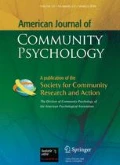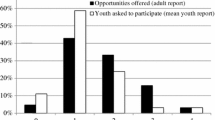Abstract
To create and sustain high quality youth development programs it is important to understand the challenging situations and dilemmas that emerge in program leaders’ daily work with youth. In this research the experiences of leaders in 12 programs were followed over a 2–9 month period, which led to the identification of 250 dilemma situations. Qualitative analyses identified 5 categories and 12 subcategories of dilemmas that reflected distinct types of considerations (e.g., youth’s personalities, relationships with the community). The analyses also found that the experienced leaders in the study typically responded to these dilemmas in ways that were youth-centered and that balanced multiple considerations. It is argued that researchers need to go beyond identifying features of high quality programs, and more fully examine how effective leaders create and sustain high quality in response to the challenging situations of practice.
Similar content being viewed by others
References
Auerbach, C. F., & Silverstein, L. B. (2003). Qualitative data: An introduction to coding and analysis. New York: New York University Press.
Banks, S. (Ed.). (1999). Ethical issues in youth work. London, England: Rutledge.
Banks, S. (2005). The ethical practitioner in formation: Issues in courage, competence and commitment. Social Work Education, 24, 737–753.
Billett, S. (2001). Knowing in practice: Re-conceptualizing vocational expertise. Learning and Instruction, 11, 431–452.
Bronfenbrenner, U. (1979). The ecology of human development: Experiments by nature and design. Cambridge, MA: Harvard University Press.
Byrnes, J. P., Miller, D. C., & Reynolds, M. (1999). Learning to make good decisions: A self-regulation perspective. Child Development, 70, 1121–1140.
Camino, L. (2005). Pitfalls and promising practices of youth-adult partnerships: An evaluator’s reflections. Journal of Community Psychology, 33, 75–85.
Dall’Alba, G., & Sandberg, J. (2006). Unveiling professional development: A critical review of stage models. Review of Educational Research, 76, 383–412.
Eccles, J. S. (2005). The present and future research on activity settings as developmental contexts. In J. Mahoney, J. Eccles, & R. Larson (Eds.), Organized activities as contexts of development (pp. 353–371). Hillsdale, NJ: Erlbaum.
Eccles, J. S., & Gootman, J. A. (Eds.). (2002). Community programs to promote youth development. Washington DC: National Academy Press.
Emmer, E. T., Evertson, C. M., & Worsham, M. E. (2003). Classroom management for secondary teachers (6th ed.). New York: Allyn and Bacon.
Ericsson, K. A. (2006). The influence of experience and deliberate practice on the development of superiour expert performance. In K. A. Ericsson, N. Charness, P. J. Feltovich, & R. R. Hoffman (Eds.), Cambridge handbook of expertise and expert performance: Its development, organization and content (pp. 683–704). Cambridge, UK: Cambridge University Press.
Ericsson, K. A., Charness, N., Feltovich, P. J., & Hoffman, R. R. (Eds.). (2006). Cambridge handbook of expertise and expert performance: Its development, organization and content. Cambridge, UK: Cambridge University Press.
Glisson, C., & James, L. R. (2002). The cross-level effects of culture and climate in human service teams. Journal of Organizational Behavior, 23, 767–794.
Halpern, R. (2005). Instrumental relationships: A potential relational model for inner-city youth programs. Journal of Community Psychology, 33, 11–20.
Hamilton, S. F., & Hamilton, M. A. (2004). Contexts for mentoring: Adolescent-adult relationships in workplaces and communities. In R. M. Lerner & L. Steinberg (Eds.), Handbook of adolescent psychology (pp. 395–428). New York: Wiley.
Harrington, H. L. (1995). Fostering reasoned decisions: Case-based pedagogy and the professional development of teachers. Teaching and Teacher Education, 11, 203–214.
Heath, S. B., & Smyth, L. (2000). Art show: Youth and community development. Washington, DC: Partners for Livable Communities.
Hoffman, R. R., & Lintern, G. (2006). Eliciting and representing the knowledge of experts. In K. A. Ericsson, N. Charness, P. J. Feltovich, & R. R. Hoffman (Eds.), Cambridge handbook of expertise and expert performance: Its development, organization and content (pp. 203–222). Cambridge, UK: Cambridge University Press.
Ilgen, D. R., Hollenbeck, J. R., Johnson, M., & Jundt, D. (2005). Teams in organizations: from input-process-output models to IMOI models. Annual Review of Psychology, 56, 517–543.
Imam, U. F. (1999). Youth workers as mediators and interpreters: Ethical issues in work with black young people. In S. Banks (Ed.), Ethical issues in youth work (pp. 125–144). London, England: Rutledge.
Jeffs, T., & Banks, S. (1999). Youth workers as controllers. In S. Banks (Ed.), Ethical issues in youth work (pp. 93–109). London, England: Rutledge.
Jorgensen, D. L. (1989). Participant observation: A methodology for human services. Thousand Oaks, CA: Sage.
Krueger, M. (2005). Four themes in youth work practice. Journal of Community Psychology, 33(1), 21–29.
Larson, R., Pearce, N., Sullivan, P., & Jarrett, R. L. (2007). Participation in youth programs as a catalyst for negotiation of family autonomy with connection. Journal of Youth and Adolescence, 36, 31–45.
Larson, R., & Walker, K. (2006). Learning about the “real world” in an urban arts program. Journal of Adolescent Research, 21, 244–268.
Lerner, R. (2002). Concepts and theories of human development (3rd ed.). Mahwah, NJ: Erlbaum.
Levin, B. B. (1994). Using the case method in teacher education: The role of discussion and experience in teachers’ thinking about cases. Teaching and Teacher Education, 11, 64–79.
Macrae, S., & Quintrall, M. (2001). Managing effective classrooms. In J. Dillon & M. Maguire (Eds.), Becoming a teacher: Issues in secondary teaching (2nd Ed.) (pp. 150–161), Philadelphia (2nd ed., pp. 150–161). Philadelphia, Pa: Open University Press.
Mayer, R. E. (2004). Should there be a three strikes rule against pure discovery learning?: The case for methods of instruction. American Psychologist, 59, 14–19.
McLaughlin, M. (2000). Community counts: How youth organizations matter for youth development. Washington, DC: Public Education Network.
McLaughlin, M., Irby, M., & Langman, J. (1994). Urban sanctuaries: Neighborhood organizations in the lives and futures of inner-city youth. San Francisco, CA: Jossey-Bass.
Miles, M., & Huberman, A. M. (1994). Qualitative data analysis. Thousand Oaks, CA: Sage.
NIMH Consortium of Editors on Development and Psychopathology. (1999). Editorial statement. Journal of Research on Adolescence, 9, 489–490.
Pace, J. L., & Hemmings, A. (2007). Understanding authority in classrooms: A review of theory, ideology, and research. Review of Educational Research, 77, 4–27.
Quinn, J. (2004). Professional development in the youth development field. Issues, trends, opportunities, and challenges. In D. B. Fink (Ed.), New directions for youth development: Doing the right thing: Ethical development across diverse environments no. 108 (pp. 13–24). San Francisco: Jossey-Bass.
Ross, K., Shafer, J. L., & Klein, G. (2006). Professional judgments and “naturalistic decision making”. In K. A. Ericsson, N. Charness, P. J. Feltovich, & R. R. Hoffman (Eds.), Cambridge handbook of expertise and expert performance: Its development, organization and content (pp. 403–419). Cambridge, UK: Cambridge University Press.
Schwandt, T. A. (2003). Back to the rough ground: Beyond theory to practice in evaluation. Evaluation, 9, 353–364.
Smith, C., & Hohmann, C. (2005). Youth program quality assessment youth validation study: Findings for instrument validation. Ypsilanti, MI: High/Scope Educational Research Foundation.
Sternberg, R. J. (1998). A balance theory of wisdom. Review of General Psychology, 2, 347–365.
Sternberg, R. J., et al. (2000). Practical intelligence in everyday life. Cambridge, UK: Cambridge.
Strauss, A., & Corbin, J. (1998). Basics of qualitative research: Techniques and procedures for developing grounded theory (2nd ed.). Thousand Oaks, CA: Sage.
Walker, J. (2003). The essential youth worker. In F. A. Villarruel, D. F. Perkins, L. M. Borden, & J. G. Keith (Eds.), Community youth development: Programs, policies, and practices (pp. 373–393). Thousand Oaks, CA: Sage.
Walker, K. C., & Larson, R. W. (2006). Balancing the professional and the personal. In D. A. Blyth & J. A. Walker (Eds.), New directions for youth development: Exceptional learning experiences for the middle years: Where high quality programs meet basic youth needs. no. 112 (pp. 109–118). San Francisco: Jossey-Bass.
Weiss, H. B., Kreider, H., Lopez, M. E., & Chatman, C. M. (Eds.). (2005). Preparing educators to involve families: From theory to practice. Thousand Oaks, California: Sage.
Yohalem, N., & Pittman, K. (2006). Putting youth work on the map. Washington, DC: Forum on Youth Investment.
Yohalem, N., & Wilson-Ahlstrom, A. (2007). Measuring youth program quality: A guide to assessment tools. Washington, DC: The Forum for Youth Investment, Impact Strategies.
Young, K. (1999). The art of youth work. Lyme Regis: Russell House.
Zeldin, S., & Camino, L. (1999). Youth leadership: Linking research and program theory to exemplary practice. Research and Practice, 15, 10–15.
Acknowledgments
We would like to thank the program leaders and youth who shared their experiences with us. We also thank the William T. Grant Foundation for its support of this research; Joyce Walker, Andrew Tonachel, and Ted Christians for their input and ideas; and Nickki Pearce, Vikki Rompala, Aimee Rickman, Jane Brown, Patrick Sullivan, and Chidori Harris for valuable contributions to this work.
Author information
Authors and Affiliations
Corresponding author
Rights and permissions
About this article
Cite this article
Larson, R.W., Walker, K.C. Dilemmas of Practice: Challenges to Program Quality Encountered by Youth Program Leaders. Am J Community Psychol 45, 338–349 (2010). https://doi.org/10.1007/s10464-010-9307-z
Published:
Issue Date:
DOI: https://doi.org/10.1007/s10464-010-9307-z




